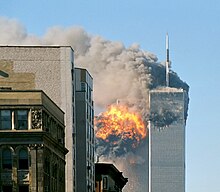He graduated from Cardinal Spellman High School in New York City in 1974. [1]

Dana, Keith and Alyssa. [2]
According to the
9/11 Commission Report, audio and video recordings prominently featuring Orio Palmer have played an important role in the ongoing analysis of problems with
radio communications during the September 11 attacks.
[3]
In 2004, the 9/11 Commission Report relied on analysis of the North Tower lobby conversations between Palmer, Peter Hayden and Donald Burns in the film shot by Jules and Gedeon Naudet to better understand what was working and wasn't working in the fire department's communications in those critical minutes. The report stated that, "Of particular concern to the chiefs--in light of FDNY difficulties in repsponding to the 1993 bombing--was communications capability. One of the chiefs recommended testing the repeater channel to see if it would work." [3] Peter Hayden, who survived, later testified, "People watching on TV certainly had more knowledge of what was happening a hundred floors above us than we did in the lobby. . . .[W]ithout critical information coming in . . . it's very difficult to make informed, critical decisions". [3]
The 9/11 Commission carefully analyzed the radio communications, and reported that the battalion chief (Palmer) was able to maintain radio communication that "worked well" with the senior chief in the lobby of the South Tower during the first fifteen minutes of his ascent. A message from a World Trade Center security official that the impact was on the 78th floor was relayed to Palmer, and he decided to try to take his team to that level. Beginning at 9:21 AM, Palmer was no longer able to reach the lobby command post, but his transmissions were recorded and analyzed later. He and his team reached the 78th floor sky lobby and were able to free a group of civilians trapped in an elevator at 9:58 AM. Palmer radioed that the area was open to the 79th floor, "well into the impact zone", and reported "numerous civilian fatalities in the area". One minute later, at 9:59 AM, the South Tower collapsed, killing everyone still inside. [3]
Although they lost their lives themselves, Palmer and his crew had played an "indispensable role in ensuring calm in the stairwells, assisting the injured and guiding the evacuees on the lower floors." [4]
Reporter Michael Daly wrote that "The 45-year-old Palmer was one of the department's rising stars, renowned for his smarts and nerve and decency, as well as his physical fitness." [5]
The video footage was shot by a French documentary crew at the North Tower. It shows Palmer conferring with Deputy Chief Peter Hayden and Assistant Chief Donald Burns at the North Tower. The South Tower had just been hit. The men discuss how to respond to the two towers, and the communications problems they faced. The sound of a falling body hitting pavement outside reverberates. According to Michael Daly, "Palmer stood steady and calm, an air pack on his back, a red flashlight bound with black elastic to his white helmet, a radio in his left hand. His face showed only a readiness to do whatever was needed." The men decided that Burns and Palmer would proceed to the South Tower.
[5]
Michael Daly concluded that Palmer was "an uncommonly brave fire chief who was one of the department's most knowledgeable minds in communications perished never knowing of warnings telephoned by at least two callers less than 30 stories above him." [5]
Marathon runner
[6]
Palmer and his men took the one remaining operating elevator to the 44th floor sky deck, as high as it would go. According to John Norman, "It took almost 55 minutes after their arrival for Battalion Chief Orio Palmer and Fire Marshall Ronnie Bucca (both marathon runners) and members of Ladder Company 15 to ascend from the 44th floor to the 78th floor (where the plane impacted the South Tower)." [6]
Palmer was "in superb condition". [7]
"Listening to Palmer and his comrades on the recovered tape, one can hear the urgency of men working at high efficiency, but there was never a hint that the clock was running out on them."
Palmer was one of the "most knowledgeable people in the department" about radio communication in high-rise fires. He "held an associate's degree in electrical technology, and had written a training article for the department on how to use repeaters to boost radio reception at high-rise fires."
[8]
References
- ^ "Orio Palmer - Alumni Page". Cardinal Spellman H. S. - Class of 1974. Retrieved February 17, 2011.
-
^ Palmer, Dana (January 29, 2002).
"Orio Joseph Palmer: Letter to a Father".
New York Times.
New York. Retrieved February 15, 2011.
{{ cite news}}: Cite has empty unknown parameter:|coauthors=( help) - ^
a
b
c
d
Chair - Kean, Thomas H. (2004). The 9/11 Commission report: final report of the National Commission on Terrorist Attacks upon the United States. W. W. Norton & Company. pp. 298–304, 547–548.
ISBN
9780393060416.
{{ cite book}}: Unknown parameter|coauthors=ignored (|author=suggested) ( help) -
^ Farmer, John (February 6, 2005).
"A September Morning".
Washington Post.
Washington, DC. Retrieved February 14, 2011.
{{ cite news}}: Cite has empty unknown parameter:|coauthors=( help) - ^
a
b
c Daly, Michael.
"His Brave Voice Resounds".
New York Daily News.
New York. Retrieved February 14, 2011.
{{ cite news}}: Cite has empty unknown parameter:|coauthors=( help) - ^ a b Norman, John (2005). Fire Officer's Handbook of Tactics. PennWell Books. p. 341. ISBN 9781593700614.
- ^ Hoffer, Peter Charles (2006). Seven fires: the urban infernos that reshaped America. PublicAffairs. ISBN 9781586483555.
-
^ Dwyer, Jim (2006).
102 Minutes: The Untold Story of the Fight to Survive Inside the Twin Towers.
Macmillan.
ISBN
9780805080322.
{{ cite book}}: Unknown parameter|coauthors=ignored (|author=suggested) ( help)